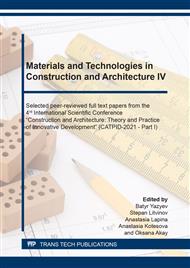p.1
p.9
p.15
p.27
p.37
p.43
p.49
p.55
Pressed Magnesia Composites with Improved Weather Resistance Properties
Abstract:
The results of studies aimed at increasing the resistance to weathering of building products based on magnesia cement are presented. This goal was achieved by the use of mine burnt rock as a modifying additive and the use of molding sands compaction pressing method. The influence of the modifier on the compressive strength change of compressed composites in dried and water-saturated state, the softening and air resistance coefficients, as well as the linear deformations of the control samples after a specified number of alternating wetting and drying cycles, was investigated. The physical and mechanical characteristics of the control samples were determined according to the standard and generally accepted methods. The formation of a complex combined structure of modified magnesian composites, containing coagulation, condensation and crystallization phases with a clear predominance of the first, has been confirmed by the physicochemical analysis methods. It is shown that modification of magnesian cement with burnt rock purposefully changes the processes of structure formation and causes an increase in water and air resistance of pressed composites based on it. The proposed method for modifying pressed magnesia products prevents loosening of their structure under alternating stresses, reduces linear deformations and, as a result, slows down fatigue failure. The involvement of a secondary resource in the composition of molding sands as an active mineral additive leads to a decrease in the cost of products and allows the method of their production to be attributed to the best available technologies. The developed compositions of pressed magnesia composites are recommended for the production of small-piece products used in building envelopes, as well as for flooring in the rooms with more than 60% humidity.
Info:
Periodical:
Pages:
27-35
Citation:
Online since:
August 2021
Authors:
Price:
Сopyright:
© 2021 Trans Tech Publications Ltd. All Rights Reserved
Share:
Citation:


